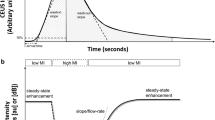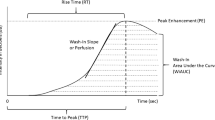Abstract
Brain contrast-enhanced ultrasound offers insights into the brain beyond the anatomic information offered by conventional grayscale ultrasound. In infants, the open fontanelles serve as acoustic windows. In children, whose fontanelles are closed, the temporal bone serves as the ideal acoustic window due to its relatively smaller thickness than the other skull bones. Diagnosis of common neurologic diseases such as stroke, hemorrhage, and hydrocephalus has been performed using the technique. Transtemporal ultrasound and contrast-enhanced ultrasound, however, are rarely used in children due to the prevalent notion that the limited acoustic penetrance degrades diagnostic quality. This review seeks to provide guidelines for the use of transtemporal brain contrast-enhanced ultrasound in children.






Similar content being viewed by others
References
Gumus M, Oommen KC, Squires JH (2021) Contrast-enhanced ultrasound of the neonatal brain. Pediatr Radiol. https://doi.org/10.1007/s00247-021-05157-x
Eyding J, Fung C, Niesen W-D, Krogias C (2020) Twenty years of cerebral ultrasound perfusion imaging—Is the best yet to come? J Clin Med. https://doi.org/10.3390/jcm9030816
Vinke EJ, Kortenbout AJ, Eyding J, Slump CH, van der Hoeven JG, de Korte CL et al (2017) Potential of contrast-enhanced ultrasound as a bedside monitoring technique in cerebral perfusion: a systematic review. Ultrasound Med Biol 43:2751–2757. https://doi.org/10.1016/j.ultrasmedbio.2017.08.935
Hwang M, Sridharan A, Darge K, Riggs B, Sehgal C, Flibotte J et al (2019) Novel quantitative contrast-enhanced ultrasound detection of hypoxic ischemic injury in neonates and infants: pilot study 1. J Ultrasound Med 38:2025–2038. https://doi.org/10.1002/jum.14892
Prada F, Bene MD, Fornaro R, Vetrano IG, Martegani A, Aiani L et al (2016) Identification of residual tumor with intraoperative contrast-enhanced ultrasound during glioblastoma resection. Neurosurg Focus 40:E7. https://doi.org/10.3171/2015.11.FOCUS15573
Squires JH, Beluk NH, Lee VK, Yanowitz TD, Gumus S, Subramanian S et al (2022) Feasibility and safety of contrast-enhanced ultrasound of the neonatal brain: a prospective study using MRI as the reference standard. AJR Am J Roentgenol 218:152–161. https://doi.org/10.2214/AJR.21.26274
Zunker P, Wilms H, Brossmann J, Georgiadis D, Weber S, Deuschl G (2002) Echo contrast-enhanced transcranial ultrasound: frequency of use, diagnostic benefit, and validity of results compared with MRA. Stroke 33:2600–2603. https://doi.org/10.1161/01.str.0000035285.43467.ff
Kern R, Diels A, Pettenpohl J, Kablau M, Brade J, Hennerici MG et al (2011) Real-time ultrasound brain perfusion imaging with analysis of microbubble replenishment in acute MCA stroke. J Cereb Blood Flow Metab 31:1716–1724. https://doi.org/10.1038/jcbfm.2011.14
Hwang M, Haddad S, Tierradentro-Garcia LO, Alves CA, Taylor GA, Darge K (2022) Current understanding and future potential applications of cerebral microvascular imaging in infants. Br J Radiol. https://doi.org/10.1259/bjr.20211051
Hwang M, Tierradentro-García LO, Hussaini SH, Cajigas-Loyola SC, Kaplan SL, Otero HJ et al (2022) Ultrasound imaging of preterm brain injury: fundamentals and updates. Pediatr Radiol 52:817–836. https://doi.org/10.1007/s00247-021-05191-9
Vitale V, Rossi E, Di Serafino M, Minelli R, Acampora C, Iacobellis F et al (2018) Pediatric encephalic ultrasonography: the essentials. J Ultrasound. https://doi.org/10.1007/s40477-018-0349-7
Hwang M, Barnewolt CE, Jüngert J, Prada F, Sridharan A, Didier RA (2021) Contrast-enhanced ultrasound of the pediatric brain. Pediatr Radiol 51:2270–2283. https://doi.org/10.1007/s00247-021-04974-4
Freeman CW, Hwang M (2022) Advanced ultrasound techniques for neuroimaging in pediatric critical care: a review. Children (Basel). https://doi.org/10.3390/children9020170
Simms DL, Neely JG (1989) Thickness of the lateral surface of the temporal bone in children. Ann Otol Rhinol Laryngol 98:726–731. https://doi.org/10.1177/000348948909800913
Demené C, Robin J, Dizeux A, Heiles B, Pernot M, Tanter M et al (2021) Transcranial ultrafast ultrasound localization microscopy of brain vasculature in patients. Nat Biomed Eng 5:219–228. https://doi.org/10.1038/s41551-021-00697-x
Miller DL, Averkiou MA, Brayman AA, Everbach EC, Holland CK, Wible JH et al (2008) Bioeffects considerations for diagnostic ultrasound contrast agents. J Ultrasound Med 27:611–632. https://doi.org/10.7863/jum.2008.27.4.611 (quiz 633)
Seidel G, Meairs S (2009) Ultrasound contrast agents in ischemic stroke. Cerebrovasc Dis 27(Suppl 2):25–39. https://doi.org/10.1159/000203124
Sridharan A, Riggs B, Darge K, Huisman TAGM, Hwang M (2021) The wash-out of contrast-enhanced ultrasound for evaluation of hypoxic ischemic injury in neonates and infants: preliminary findings. Ultrasound Q. https://doi.org/10.1097/RUQ.0000000000000560
Hwang M, Riggs BJ, Saade-Lemus S, Huisman TA (2018) Bedside contrast-enhanced ultrasound diagnosing cessation of cerebral circulation in a neonate: a novel bedside diagnostic tool. Neuroradiol J 31:578–580. https://doi.org/10.1177/1971400918795866
Hwang M (2019) Introduction to contrast-enhanced ultrasound of the brain in neonates and infants: current understanding and future potential. Pediatr Radiol 49:254–262. https://doi.org/10.1007/s00247-018-4270-1
Yeom KW, Lober RM, Alexander A, Cheshier SH, Edwards MSB (2014) Hydrocephalus decreases arterial spin-labeled cerebral perfusion. AJNR Am J Neuroradiol 35:1433–1439. https://doi.org/10.3174/ajnr.A3891
Zhang Z, Hwang M, Kilbaugh TJ, Sridharan A, Katz J (2022) Cerebral microcirculation mapped by echo particle tracking velocimetry quantifies the intracranial pressure and detects ischemia. Nat Commun 13:666. https://doi.org/10.1038/s41467-022-28298-5
Sidhu PS, Cantisani V, Deganello A, Dietrich CF, Duran C, Franke D et al (2017) Role of contrast-enhanced ultrasound (CEUS) in paediatric practice: an EFSUMB position statement. Ultraschall Med 38:33–43. https://doi.org/10.1055/s-0042-110394
Ntoulia A, Anupindi SA, Back SJ, Didier RA, Hwang M, Johnson AM et al (2021) Contrast-enhanced ultrasound: a comprehensive review of safety in children. Pediatr Radiol 51:2161–2180. https://doi.org/10.1007/s00247-021-05223-4
Acknowledgements
The authors would like to acknowledge Lydia Sheldon, M.S. Ed., medical writer at Children’s Hospital of Philadelphia, Department of Radiology, for editing this manuscript and Brittany Bennett, M.A., medical illustrator at Children’s Hospital of Philadelphia, Department of Radiology, for providing Fig. 1.
Funding
The authors have not disclosed any funding.
Author information
Authors and Affiliations
Corresponding author
Ethics declarations
Conflict of Interest
The author reports no disclosures relevant to the manuscript.
Additional information
Publisher's Note
Springer Nature remains neutral with regard to jurisdictional claims in published maps and institutional affiliations.
Supplementary Information
Below is the link to the electronic supplementary material.
Videoclip. A 1-year-old boy with normal brain underwent transtemporal CEUS. This clip represents the midbrain and the perimesencephalic region in the axial plane during the wash-in phase (first 30 seconds after contrast injection). There is avid enhancement of the perimesencephalic vessels; a grayscale clip is shown on the right for comparison. (MP4 5260 KB)
Rights and permissions
About this article
Cite this article
Hwang, M., Tierradentro-Garcia, L.O. A concise guide to transtemporal contrast-enhanced ultrasound in children. J Ultrasound 26, 229–237 (2023). https://doi.org/10.1007/s40477-022-00690-3
Received:
Accepted:
Published:
Issue Date:
DOI: https://doi.org/10.1007/s40477-022-00690-3




